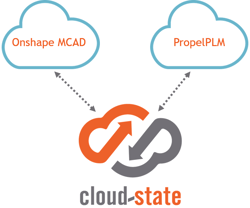Recently, I’ve attended two Product Lifecycle Management (PLM) events and talked with many customers about their 2017 plans, and carving a path to the cloud is a common theme. And yes, this is not surprising. We’ve seen many reports for a couple of years now, including this one stating, “1/3 of all data will exist in or pass through the cloud by 2020”. One thing that remains consistent is the need for companies to seamlessly and securely integrate all of their various applications, whether they live in the cloud or not. Hence, we created our first cloud-based integration framework, CloudState. CloudState is a hosted integration framework for PLM systems product that aims to integrate cloud-to-cloud and cloud-to-on premise applications. This blog will elaborate on CloudState, provide an example of the product in action, and hopefully show you we're here to help you answer the question, "To the cloud, or not to the cloud".
 We previewed an early version of CloudState at the Pacific Design and Manufacturing conference and officially announced CloudState during last week’s Engineering.com webinar, which we co-presented with 2 of our cloud-based partners: PropelPLM, a cloud-based PLM system built on top of the SalesForce.com platform and Onshape, an MCAD system completely based in the cloud from the founders of SolidWorks. Our CloudState product plan is to launch general availability Spring 2017.
We previewed an early version of CloudState at the Pacific Design and Manufacturing conference and officially announced CloudState during last week’s Engineering.com webinar, which we co-presented with 2 of our cloud-based partners: PropelPLM, a cloud-based PLM system built on top of the SalesForce.com platform and Onshape, an MCAD system completely based in the cloud from the founders of SolidWorks. Our CloudState product plan is to launch general availability Spring 2017.
Both Onshape and PropelPLM are at the forefront of today’s move by new start-ups to be completely hosted in the cloud: from email, calendaring and office applications to ERP, PLM, Quality, EHS and now CAD. In fact, the only IT infrastructure new startup companies have are laptops, tablets, mobile phones and Wi-Fi. But, we also see more established companies start to plan or make their move to the cloud.
 In CloudState, one configures the data mapping, data transformations and business rules between different cloud and non-cloud applications. The tool takes care of the connectivity including using firewall friendly REST interfaces to connect with applications behind your company’s firewall. The goal is to keep your current non-cloud applications relevant as you plan or make your move to the cloud.
In CloudState, one configures the data mapping, data transformations and business rules between different cloud and non-cloud applications. The tool takes care of the connectivity including using firewall friendly REST interfaces to connect with applications behind your company’s firewall. The goal is to keep your current non-cloud applications relevant as you plan or make your move to the cloud.
As I said earlier, we’ve demonstrated how CloudState connects Onshape and PropelPLM in order to enable typical CAD use cases such as pulling part numbers from the PLM system, publishing a BOM from CAD to PLM, hyperlinking corresponding parts in CAD and PLM, linking back to models and drawings in the CAD tool and initiating changes from the CAD tool in PLM. An overview demo is available HERE.
This Onshape to Propel integration is but one of the different integrations we provide. Other integrations using CloudState are forthcoming such as an integration between Onshape and Oracle Agile PLM and Onshape to Oracle PLM cloud-based products. We are also working on integrating other systems with on premise and cloud based PLM applications.
So, as the title suggest, moving to the cloud is one of the top questions for 2017 and beyond, and likely the answer is yes, but carving a path forward is still a challenge. Stay tuned for more exciting product news in the coming months. Please comment on your thoughts and any must-have features you think are necessary in CloudState.



